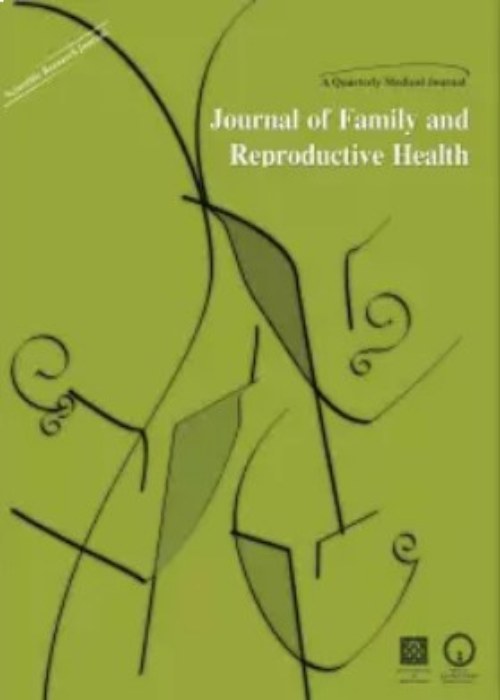فهرست مطالب

Journal of Family and Reproductive Health
Volume:10 Issue: 2, Jun 2016
- تاریخ انتشار: 1395/05/04
- تعداد عناوین: 8
-
-
Pages 52-58ObjectiveTo determine the prevalence of sexual problems in Iranian women and association of sexual dysfunction with menopausal symptoms.Materials And MethodsIn this cross-sectional study, 151 married women with the age of 40-60 yearsold who were referred for treatmentto Department of Gynecology in Vali-e-Asr Hospital (Tehran, Iran) from April to July 2012, were recruited. They were evaluated concerning their sexual function in the domains of desire, arousal, lubrication, orgasm, satisfaction and pain with the female sexual function index (FSFI) questionnaire.Menopause rating scale (MRS) was developed for the diagnosis and quantification of climacteric symptoms.ResultsTotal frequency of sexual dysfunction was 53% with the domains of lubrication, arusal and desire being commonly affected 62%, 70% and 98.5% of cases respectively. There is a relationship between severity of somatic and urogenital symptoms with sexual dysfunction (p = 0.03, p = 0.00 respectively).ConclusionA considerable percentage of women experienced sexual dysfunctions in this period. Somatic and urogenital symptoms during the menopausal period could be a factor to maintain or intensity of sexual dysfunctions.Keywords: Sexual Dysfunction, Menopause, Psychological Sexual Dysfunction, Libido, Arousal, Female Sexual Function Index
-
Pages 59-63ObjectiveTo evaluate the plasma creatine phosphokinase (CPK) level after injection of methotrexate (MTX) as a predictor of treatment success in ectopic pregnancy (EP).Materials And MethodsOne hundred women treated with single dose of methotrexate for ectopic pregnancy were evaluated in a prospective study, for CPK and ß-subunit of human chorionic gonadotropin (ß-hCG) levels. They received intramuscular MTX at a dose of 50 mg/m2. The day of injection was considered as day 1 (D1). CPK level on the day of Methotrexate injection was compared between success group who were treated by a single MTX injection, and the unsuccessful groupwho were treated by two or three MTX injections or by surgery.ResultsThe success rate of single dose of MTX injection was 78 (78%). The mean of CPK was higher in success group than unsuccessful group. (86 ± 10.7 vs. 73 ± 11.8), the difference was significant
(p = 0.04). The mean of ß-hCG was significantly lower in treatment success group than unsuccessful group (1421.3 ± 443.6 vs. 1925.6 ± 185.4, p = 0.01).ConclusionThe success of single dose of MTX treatment in ectopic pregnancy may be predicted by CPK levels and the higher levels of CPK may be useful for detecting of patients with successful response to MTX.Keywords: Methotrexate, CPK, Ectopic Pregnancy -
Pages 64-70ObjectiveReports of increased level of Myeloperoxidase (MPO) in plasma and placental extracts of Systematic Lupus Erythematosus (SLE) has been proposed that MPO may have an important role in this pregnancy complication. In present study immunohistochemical MPO expression was investigated in placental samples of SLE women compared with normal controls.Materials And MethodsTen patients with SLE were recruited as case group. Control group was selected from mothers with normal uncomplicated pregnancies. A monoclonal antibody specific for MPO was used for immunohistochemical staining and then the staining was quantified and differences between groups were compared using Mann-Whitney U test.ResultsThere were significant differences in the expression levels of MPO in the syncytiotrophoblast cells and the extravillous trophoblast cells between the control and SLE groups (p 0.05).ConclusionThe present study showed that MPO expression is increased in syncytiotrophoblast cells and the extravillous trophoblast cells of SLE placentas compared to healthy subjects. It seems that these changes are able to impress structure and function of placenta and survival of the fetus.Keywords: Lupus Erythematosus, Placenta, Trophoblasts, Peroxidase, Immunohistochemistry, Pregnancy Complications
-
Pages 71-79ObjectiveTo evaluate the effect of cytoplasm transfer from mature oocytes to germinal vesicle(GV)s on promoting the maturation of cytoplasm of GV at the mRNA level.Materials And MethodsSixty six in vitro fertilization (IVF) operations between June 2012 and November 2013 were included in this study. Totally 120 GVs were obtained. Normal GVs were categorized into 3 groups (n = 40) randomly: the first comprised oocytes that did not receive the cytoplasm of mature oocytes; the second group comprised oocytes that did not receive the cytoplasm of mature oocytes but were incubated for 24 h; and the third group comprised oocytes that received 10-15% the cytoplasm of mature oocytes and were then incubated for 24 h. Each group was separately analyzed by quantitative polymerase chain reaction (qPCR) and the expression levels of selected genes were assessed.ResultsThe expression levels of genes involved in the cytoplasmic maturity, and energy-producing mitochondria were significantly higher in the pooled oocytes of 2nd control group than those of the 1st control and intervention groups (pConclusionThe cytoplasm transfer technique is not effective in cytoplasmic maturity of the recipient GV oocytes. In contrast, 24-hr in-vitro culture is associated with increased expression of studied genes in GVs.Keywords: Gene Expression, Cytoplasmic Transfer, Oocyte Maturity
-
Pages 80-84ObjectiveTo evaluate the importance of cytokine type in embryo implantation in uterus specified and activated macrophages interfere the tube movements and embryo retention in uterine tubes by smooth muscle relaxation and disrupting ciliary function. Therefore, increased risk of infection with HP during pregnancy, we investigated relation between Helicobacter pylori (HP) infection and prevalence of ectopic pregnancy (EP) in this study.Materials And MethodsThis is cross-sectional study from March 2012 to May 2013. Totally 207 women were enrolled randomly from which 101 had EP (Case group) and 106 were selected as control group with normal pregnancy. A 2-cc blood sample was taken from each patient to evaluate the specific IgG titer by ELISA method. All results of samples with positive H. pylori IgG were assayed for anti-CagA, IgG antibodies. A questionnaire was filled for each subject. The associations between CagA positive cases with odds of Ectopic pregnancy incidence were analyzed by using SPSS software, ver. 19 (Chicago, IL, USA).ResultsMean (± SD) of age were 21.0 ± 5.78 and 30.78 ± 5.10 years for cases and controls group respectively. These groups didnt show any significance difference in age and parity.H. pylori IgG antibodies were positive among 99 and 103 (98.2% vs. 97.2%) in women with EP and normal pregnancy respectively. Relationship between IgG status and EP was not significant (OR = 1.31: 95% CI = 0.7-2.52, Pvalue = 0.37). In particular anti-CagA antibodies were positive among 45 and 39(45.92% vs. 36.97%) in women with EP and normal pregnancy respectively. Among women with CagA positive strains had higher odds of Ep (OR = 1.46: 95% CI = 0.8-2.65, Pvalue = 0.18), but it wasnt significant.ConclusionAccording to the result of this study there was not any association between HP infection and Ectopic pregnancy. We recommend more studies with larger sample size for determining the effect of CagA positive strains on EP.Keywords: Ectopic Pregnancy, IgG, CagA Antibody, Helicobacter Pilory
-
Pages 85-91ObjectiveMaternal type and amounts of dietary fatty acids affect on reproductive process in the mice. The present study investigated the effects of maternal supplementation with different amounts of omega-6 or omega-9 during pregnancy on the number of offspring, sex-ratio and duration of gestation.Materials And MethodsEight-week-old female C57BL/6 mice were randomly assigned into four dietary groups including low omega-6 (16%; LO6), low omega-9 (16%; LO9), high omega-6 (45%; HO6) and high omega-9 (45%; HO9) during gestation. Number of offspring, sex-ratio and duration of pregnancy were compared among four dietary groups.ResultsThere was significant difference between LO6 and HO6 (pConclusionHigh fat diet reduced number of pups, gestation duration and lead to early labor. Omega-9 fatty acids shifted sex of offspring to females.Keywords: Gestation, Sex Ratio, Offspring, Dietary Oil
-
Pages 92-98ObjectivePolycystic ovary syndrome (PCOS) is one of the most common endocrine disorders that is associated with different metabolic, reproductive and psychological consequences. The main aim of this study was to compare the sexual function and quality of life in women with polycystic ovary syndrome and healthy women.Materials And MethodsThis is a causal-comparative study in which 129 women with polycystic ovary syndrome were qualified as the research group. The control group consisted of 125 healthy women. The sampling method was convenient and was done using Rotterdam criteria. Women of both research and control groups responded to the FSFI and WHOQOL-BREF questionnaires. Data were analyzed with SPSS software using MANOVA.ResultsAccording to findings, all of quality of life subscales except environment domain were significantly lower in research group than healthy group (p 0.05).ConclusionWomen with PCOS in term of some quality of life parameters have lower performance than healthy women. Therefore, it seems to be essential to increase awareness about symptoms and psychological consequences and referring process in order to take advantage of the advisory services.Keywords: Sexual Function, Quality of Life, Polycystic Ovary Syndrome (PCOS)
-
Pages 99-103ObjectiveTo identify the effects of community-based interventions on the Neonatal Health Index in one district of Tehran-Iran.Materials And MethodsA community and healthcare center-based study was carried out from January 2011 through September 2014. The population of the study included newborns from mothers residing in the 4th district of Tehran, Iran. Demographic data of mothers and infants were recorded in questionnaires before and after intervention. Interventions were implemented in hospitals, participant's homes, and health centers. The primary outcomes were comparison of mean birth weight, weight gain during the first 3-7 days, first week visit rate, hospitalization rate between the before and after intervention groups.ResultsThe populations in the before and after intervention groups were 274 and 250, respectively. A significant difference was seen between the gestational ages (P value = 0.007) of the two groups. Mean birth height in the first group was 50.35 ± 3.48 and in the second group was 55 ± 5.32 cm (P value = 0.04). Neonatal complications in the second group were 6.9% lower than in the first group (P value = 0.048). In the first group 41 neonates (15%) were hospitalized in the NICU while in the second group 12 cases (4.8%) were hospitalized (P value = 0.018). Seven cases (2.6%) in the first group and one case (0.4%) in the second group were resuscitated (P value = 0.0001).ConclusionThe results of implementing community-based newborn care strategies witnessed at the first week postnatal visit included improvements inneonatal gestational growth, management of neonates with potentially serious illnesses, diagnosis of warning signs and neonatal care practices.Keywords: Community, Based, Intervention Packages, Neonatal Health Status


